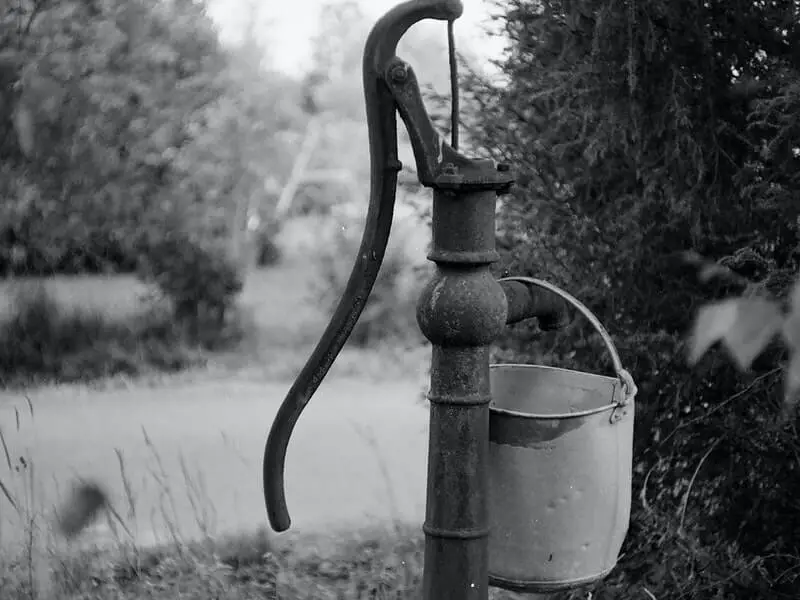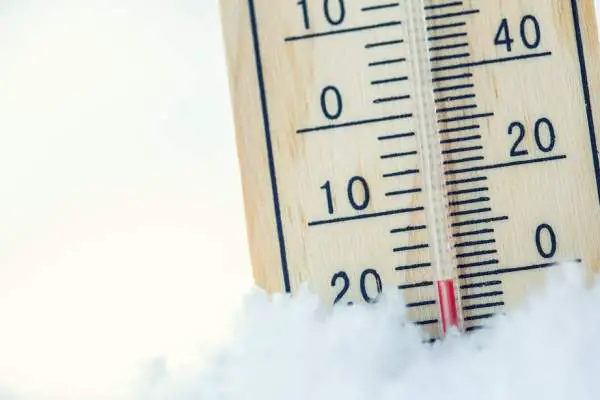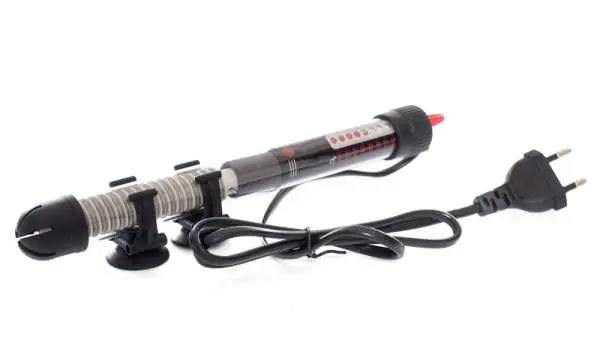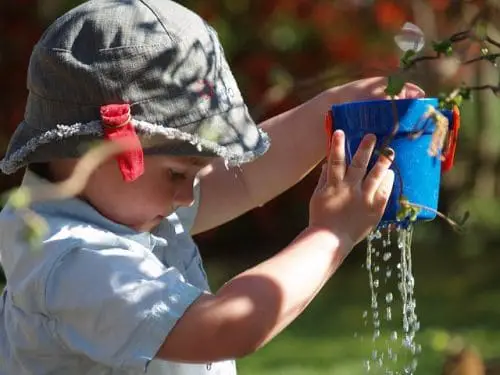As hydroponic growers, one of the most annoying issues we have to deal with all the time is keeping the plants’ roots in the perfect water temperature.
That’s because as soon as the temperature reaches a certain point, the nutrient solution can’t hold the dissolved oxygen for long, resulting in root rot.
In the following article, we will look at eight different ways to cool off your hydroponic reservoir and solution.
Moreover, we will also talk about the perfect nutrient and environmental temperature you need to aim at to have fruitful and constant plant growth, free of issues and diseases.
1# Keep Your Reservoir in the Shade

Any grower should be doing this one thing by default. Being able to minimize the amount of light which falls on your reservoir will help prevent it from warming up in the first place. Aside from this, you also need to be sure no light is entering your reservoir, this will warm it quicker, and it does allow algae to form along the water line.
2# Paint or Insulate Your Reservoir
There are two things you can try in this solution. The problem doesn’t just come from tanks, which are in a warm environment. Nutrient tanks can catch the heat from grow lights. As soon as this starts to hit the dark colors of your tanks, then the solution inside begins to warm up.
Solutions for this are to either paint your reservoir a light color as a way of reflecting the light and the heat, or you can cover your tank in a reflective insulation material. Even regular insulation can be enough to help maintain cooler temperatures in your tank, yet reflective insulation comes with an added benefit.
Once your grow lights hit the top of your tank, this reflective material bounces light back, which can reach the undersides of your plants.
In summary, here are things to know about painting or insulating your tank:
- Don’t choose a light plastic to save on painting, this can lead to algae growth when light passes through
- Dark plastics absorb more heat while light colors reflect
- Reflective insulation helps cool, and throws light back onto your plants
3# Increase Your Reservoir Size
Depending where hydroponic gardens are located, this often dictates the size of reservoir in use. For small gardens, growers tend to go for a smaller tank to match, however, these warm up quicker than larger reservoirs.
If you add a larger reservoir, your nutrient mix becomes more stable. This doesn’t just mean you can keep lower temperatures, but also it helps balance pH levels, PPM and other concentrations in your mixture.
- Small reservoirs fluctuate easier
- Large reservoirs add stability for controlling temperature and other factors
- PPM, EC and pH are easier to control in larger tanks
4# Top Off Your Solution
If you need a quick fix, then this can suffice to drop your temperatures down a few degrees on hot days. This method shouldn’t be used too often because either you will be diluting your nutrient mix, or you will be using more nutrients than you need to.
It is better to use this method in case of emergencies because if you have temperature fluctuations, they will always be there, and this method doesn’t do much to eliminate them.
- Not to be used all the time
- Add cooler solution slowly so not to shock plants
5# Bury Your Reservoir
This method only works if you have an outside hydroponic garden. You can prevent several problems with your nutrient tank by burying it. This helps to maintain cooler temperatures but using the natural coolness of the earth, and it is sure to stop any light from entering your tank.
The main things to remember with this method are you may struggle when you come to flush your tank between growing. If it is already under ground level, you may not have a suitable drain point.
6# Make Your Own Swamp Coolers
Swamp coolers are effective, and very simple to make. All it requires is to take a suitable fan and blow this across the top of your nutrient solution. As a result, you may see temperature drops of around 5 to 10F.
The downside to this is you can be topping off your reservoir more often to compensate for evaporation. Second to this, your EC and PPM levels will rise that will require continual adjustment. You may also find using this method, you are allowing light into your tank.
7# Make a Cooling Coil
While these can be effective, they do take more work and they have the downside of wasting water. To make one of these, you can take copper or stainless steel tubing and form it into around 20 coils. This will then sit inside your reservoir with a hose connected to both ends.
One fits on the faucet while the second drains. In operation, the water trickles through the tubing and will pull heat from your reservoir into the liquid inside.
- Wastes water
- Can offer unlimited cooling at a cost
- Doesn’t need any power
8# Buy a Water Chiller
One of the most efficient ways to cool your reservoir is to purchase a water chiller. These deliver a hands free approach and give you lots of control. These do become more cost-effective if you have more than a couple of tanks where you need to control the temperatures.
These water chillers can be a hefty investment, and they do consume electricity for their operation. There are varying sizes so scaling up to any sized garden can be straightforward.
- Most expensive option
- Still requires water pumps
- Can be a set it and forget it solution
- Ideal for larger gardens
Ideal Hydroponics Temperature

Plants thrive better when they are in a constant environment. While nutrient temperature can fluctuate, the main problem can stem from the grow room itself.
For ideal temperatures for good plant growth, the surrounding environment should be around 70 to 80F. For optimum root growth, the ideal temperatures of the root zone should be around 66F.
Once the temperatures are above these, then stress starts to show in your plants. Heat stress can cause plants that are spindly in the early stages of growth, and mature plants can fail to fruit or flower correctly.
Most of the above methods focus on cooling a nutrient mix which is already warm. However, to have the perfect grow room will mean that your tanks temperature doesn’t climb in the first place.
Here are some of the best ways you can help maintain your grow room environment.
Air conditioners: This works as well as a water chiller, but for the surrounding environment. The environment will warm because of grow lights, or any natural light, which spills in through windows. You can purchase window type air conditioners that are ideal to cool your grow room enough without breaking the bank.
Relocate or Insulate Grow Rooms: The biggest culprit for tanks heating up will be your grow lights. If your grow room faces the south, or your grow room is under a hot roof, you may be fighting a losing battle with your tank temperatures.
Insulating your grow room can prevent hot weather having an impact. Additionally, if you can move a grow room into the basement, you will find it is naturally cooler than above ground level.
Increase Humidity: If your grow room suffers from low humidity, then your plants will take up more water to keep cool. This is where your tank levels drop faster and thus warm up quicker. Misting your grow room can keep plants and the surrounding areas cool, and as a result, your nutrient mix will remain stable.
Improve the Air Flow: Plants require good air circulation for healthy growth. This will also help prevent your nutrient mix from warming in the first place. Plants will benefit with circulating air, and it stops pockets or warm zones from forming around the grow room.
Run Lights at Night: One-Way of cooling a grow room which many growers often overlook is using their grow lights at night rather than in the day. Using supplemental lighting at night not only offers cheaper electric in some cases, but a grow room will be cooler at this time. The overall temperature of the room may not reach a level that will push your reservoir up to the higher limits to cause problems.
However, doing this will mean you need alternative counter measures in the day to cool your grow room. This will depend on the location as to the extent you need to go. If your grow room has access to natural light, it can be just a matter of extra shading, additional misting and fog to keep lower temperatures.
Calculating the Size of Water Chiller
One of the most crucial factors when choosing a water chiller is how well it will perform on your system. It isn’t just a matter of choosing one and expecting it to cool sufficiently. When it comes to the sizing of your water chiller, the following method allows you to determine the size of chiller unit that is sufficient for your garden system.
- Calculate your system volume – this includes all buckets and tanks
- Run your system with everything turned on – all grow lights, fans, etc.
- When your grow room has reached its max temp, take a reading before cooling your system using ice packs or frozen plastic bottles of ice.
- When your system mix cools, remove the ice and run for another hour.
- After this time, take the water temperature
- Subtract your ending temp from the starting temp
- Use the formula to find the minimum BTU required.
- System volume: 80 gallons
- Desired Temp: 65F
- Running Temp: 76F
Formula: 80 x 8.34 x 11 = 7,339 BTU (gallons x weight of water x temporary difference).
A water chiller should run around 20% above your BTU requirement minimum to counteract performance loss.
Pros and Cons of Using a Water Chiller in Your Garden
Like many things for your hydroponics system, there are pros and cons of using a water chiller.
Pros of Hydroponic Water Chillers
- Cooler temperatures enable your solution to hold a higher degree of dissolved oxygen. This is the key basis of increased nutrient uptake and explosive root growth.
- Highly oxygenated environments, which come with cooler temperatures, can help deter pathogens from taking hold.
- A cooler reservoir will act as a heat sink in your grow room. This can draw ambient heat and help to cool the whole room
Cons of Water Chillers in Hydroponic Gardens
- Expense is one of the largest primary cons for a water chiller. Although you can find affordable models, it can still be a cost that many growers can’t justify.
- Noise – in operation, these will sit outside of a reservoir like air pumps. They will make the same sort of noises as air conditioning units.
- Heat: Water chillers do generate heat when they cool water. Either they require ducting to transfer this heat out of the grow room, or they have to sit outside the grow room to not introduce more heat.
Why Do Roots Need Cool Temperatures?
Root zone temperatures affect overall shoot growth. Not only this, the impact from the root zone temperature will have more of a bearing on development and overall growth than the ambient air temperatures.
This occurs because the tissues of the roots send messages to the shoots. This will have an effect of how the shoot reacts to the environment. Growers see that there are many functions that occur for the plant in the roots, and thus, the root zone temperature becomes crucial.
Such is the effect of this, even thirty minutes of heat buildup in your nutrient mixture and in the root zone is enough to have a negative effect on your plants. One thing to note is that a daily cool average isn’t sufficient to counteract this.
As soon as your temperatures rise above 86F, then crops, which are sensitive to heat, will quickly falter such as lettuce or parsley.
When you look at something such as lettuce, the cooling of your nutrient reservoir does allow these crops to face higher than usual/ optimal temperatures above the surface.
While there are many biological happenings because of cooling roots lower than the ambient air temperatures, it is easier to know it reduces heat stress in the leaves of plants.
Root Zones and Different Hydroponic Systems
Cooling your nutrient solution to the optimal temperature isn’t all the equation. The remainder comes from the types of system you are running.
The root zone temperature needs to remain the same all the time. The cool mixture has a big influence on this, yet the system type and how it is built can affect this dramatically. A good example being the only system, which will have the same temperature root zone as the nutrients, will be a DWC system.
The roots are in constant contact with the solution. In all the other types of system, there is a degree of separation between the root zone and the reservoir.
A good example of how this can affect plants is in an ebb and flow (flood and drain) system. As your cool solution rises in the flood tables, the plants gain the advantages of oxygenated water and the roots are comfortable because of the lower temperatures.
However, things change as the cycle stops and the solution begins to drain back into the tank. Warm air from the grow room can be pulled through the growing medium as the solution drops. If the environment is warm, it can heat up your root zone considerably until the next flood cycle.
Unless you have a good means of cooling your solution, this will transfer heat back into your tank and thus warming it with each fill and drain cycle. Depending on your cooling solution, you may find that this is insufficient and as much as you are trying to cool your water, it increases in temperature regardless.
Not only will your water increase in temperature but also the root zone can be at a damaging temperature between your flood cycles.
Size of Your Hydroponics Reservoirs
One of the first things to be sure of is that you have a large enough reservoir. Rather than just being large enough for the size of system, you have, you are better to have a much larger one than you require.
Hydrotek, who are one of the largest names in hydroponic equipment recommend the following for reservoir sizes:
- Small plants – ½ gallon for each plant
- Medium plants – 1 ½ gallons for each plant
- Large plants – 2 ½ gallons for each plant
Hydrotek recommends you choose a reservoir that is at least double the size.
You also need to consider how thirsty your plants will be. This can use your water and nutrients faster, such as is the like of tomatoes in comparison to lettuce.
This will use your mix faster and thus cause a warm solution once the level starts to drop.
Using all the above information can help to maintain cooler temperatures for your nutrient solution. However, if you find your grow room comfortable for yourself as you are working in that environment, then you are halfway to knowing how it feels for your crops.





